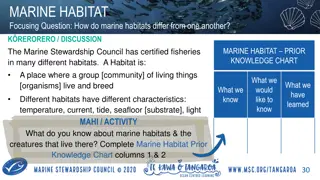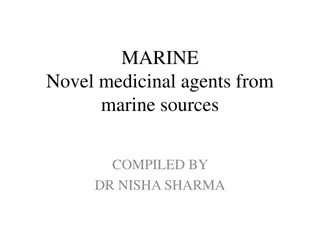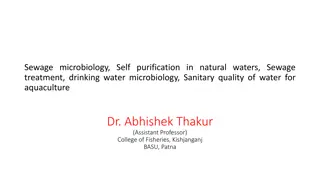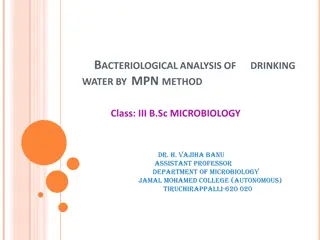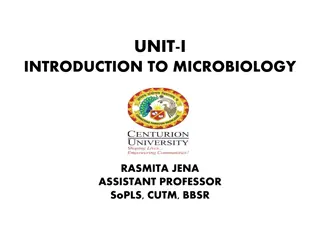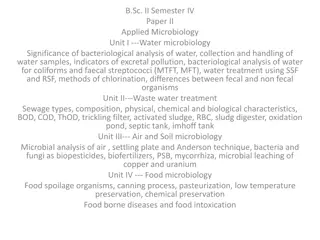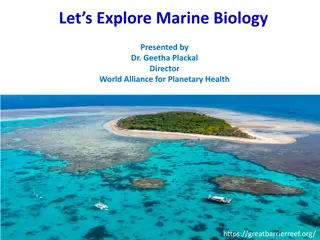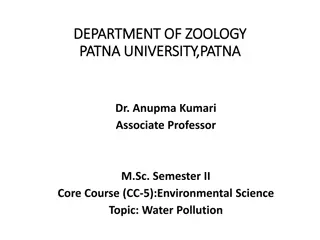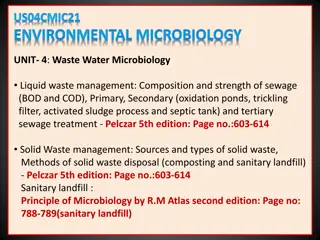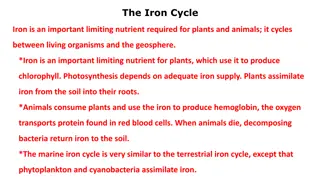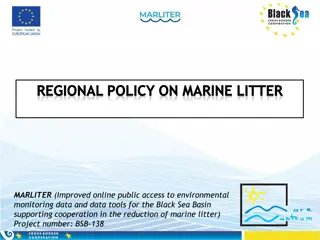Understanding Water Microbiology: Marine and Fresh Environments
Exploring water microbiology, this lecture delves into the unique ecosystems of the marine and freshwater environments. From the high-pressure, low-temperature marine environment supporting various bacterial adaptations to the nutrient-rich lakes and rivers, the role of microbial processes and organic matter in these habitats is crucial. The presentation discusses factors impacting microbial communities, such as nutrient status, organic matter levels, and pollution sources, emphasizing the importance of understanding water microbiology for ecosystem health.
Download Presentation

Please find below an Image/Link to download the presentation.
The content on the website is provided AS IS for your information and personal use only. It may not be sold, licensed, or shared on other websites without obtaining consent from the author. Download presentation by click this link. If you encounter any issues during the download, it is possible that the publisher has removed the file from their server.
E N D
Presentation Transcript
Water Microbiology lecture 2
The Marine Environment The marine environment represents the largest portion of the biosphere, containing 97% of the earth s water. The ocean has been called a high-pressure refrigerator with most of volume below 100 meters at a constant temperature 3 C. The pressure in the marine environment increases approximately 1 atm /10 meters in depth. Some bacteria are: 1- Barotolerant:(grow between 0-400 atm). 2- Barophiles:(prefer higher pressures). 3- Moderate barophiles:(grow optimally at 400 atm) 4- Extreme barophiles:(grow only at higher pressures).
Pressure biological processes including: 1- Cell division 2- Flagella assembly 3- DNA replication 4- Membrane transport 5- Protein synthesis differences influence many In illuminated surface waters, the major source of organic matter is photosynthetic activity primarily from phytoplankton such as Synechococcus which can reach densities of 104 to 105 per milliliter at the ocean surface.
The Fresh Environment Lakes environments that are different from the larger oceanic systems in many important ways. 1- Lakes: It is vary in nutrient status. Some are: A- Oligotrophic (nutrient remains aerobic throughout the year. and rivers provide microbial poor) lakes
B- Eutrophic usually have bottom sediments that contain organic matter. (nutrient rich) lakes Motile bacteria and algae migrate within the water column to again find their most suitable environment.
2- Rivers: situation horizontal water movement to minimize vertical stratification, in addition, most of the functional microbial biomass is attached to surfaces. present that a different sufficient in is
If too much organic matter is added, the water may become anaerobic. The release of inadequately treated wastes and other materials from a specific location along a river or stream represents a point source of pollution. Such point source additions of organic matter can produce distinct and predictable changes in the microbial community and available oxygen sag curve.
When the amount of organic matter added is most excessive, the algae will grow, using the mineral released from the organic matter. This production of O2 during the daylight hours and respiration will occur at night farther down the river, resulting in diurnal oxygen shifts. leads to the
Aquatic Microbiology Identification: Is the science that deals with microscopic living organisms in fresh or salt water systems. This microorganisms plants and animals. science encompass including all microscopic It more commonly refers to the study of bacteria, viruses and fungi with their relation to other organisms in the aquatic environment.
Viruses - They are the link between the living and non living organisms - They are factors have the ability to cause disease -They are found in all place like water, air, soil etc even if the only one drop of sea water contain >25 million of virus particles -To Imagine: One accommodate about 2000 viruses. While, one human can accommodate 50 million viruses. bacterial cell can
Most of aquatic viruses are bacteriophages The structure of a typical bacteriophage
Role of virus in aquatic ecosystems 1- They infect and destroy bacteria in aquatic microbial communities. 2- It is essential to the regulation of saltwater and freshwater ecosystems. 3- The organic molecules released from the dead bacterial cells stimulate fresh bacterial and algal growth. 4- Viral activity may also contribute to the biological pump (The carbon is sequestered in the deep ocean). process whereby
5- Microorganisms constitute more than 90% of the biomass in the sea. Viruses kill approximately 20% of this biomass every day. 6- Viruses are the main agents responsible for the rapid destruction of harmful algal blooms, which often kill other marine life.
The number of viruses in the oceans decreases further offshore and deeper into the water, where there are fewer host organisms. Bacteriophages are a common and diverse group of viruses environments. There are up to ten times more of these viruses in the oceans than there are bacteria 250,000,000 bacteriophages per milliliter of seawater. in the aquatic reaching levels of
Mechanism of bacterial infection by bacteriophage 1- The viruses infect specific bacteria by binding to surface receptor molecules and then entering its nucleic acid inside the cell. 2- polymerase protein. within a short starts amount translating of viral time, bacterial mRNA into 3- These proteins go on to become either new virions within the cell which help assembly of new virions or proteins involved in cell lysis. 4- Viral enzymes aid in the breakdown of the cell membrane.
Waterborne enteric viruses Enteric viruses may be present: Naturally in aquatic environments Introduced human activities through Leaking sewage Such as Agricultural runoff Over 100 types of pathogenic viruses are excreted in human and animal wastes.
These viruses known as enteric viruses because they are usually transmitted via route and primarily infect and replicate in the gastrointestinal tract of the host. the fecal-oral
The human diseases caused by enteric viruses 1- Diarrhea 2- self-limiting gastroenteritis in human 3- Respiratory infections 4- Conjunctivitis 5- Hepatitis 6- Diseases that have high mortality rates such as:A-Aseptic meningitis B- Paralysis 7- Caused other chronic diseases
Viruses have been reported to survive and remain infective for up to 130 days in seawater, for up to 120 days in freshwater and sewage and for up to 100 days in soil at 20-30 C. Pathogenic viruses are generally more resistant than bacterial indicators during conventional wastewater treatment such as chlorination and filtration.
In general: Enteric viruses show great potential to be used as water quality indicators to assess the risk associated with infectious virus transmission as well as to identify the dominant contamination in waters. source of fecal




